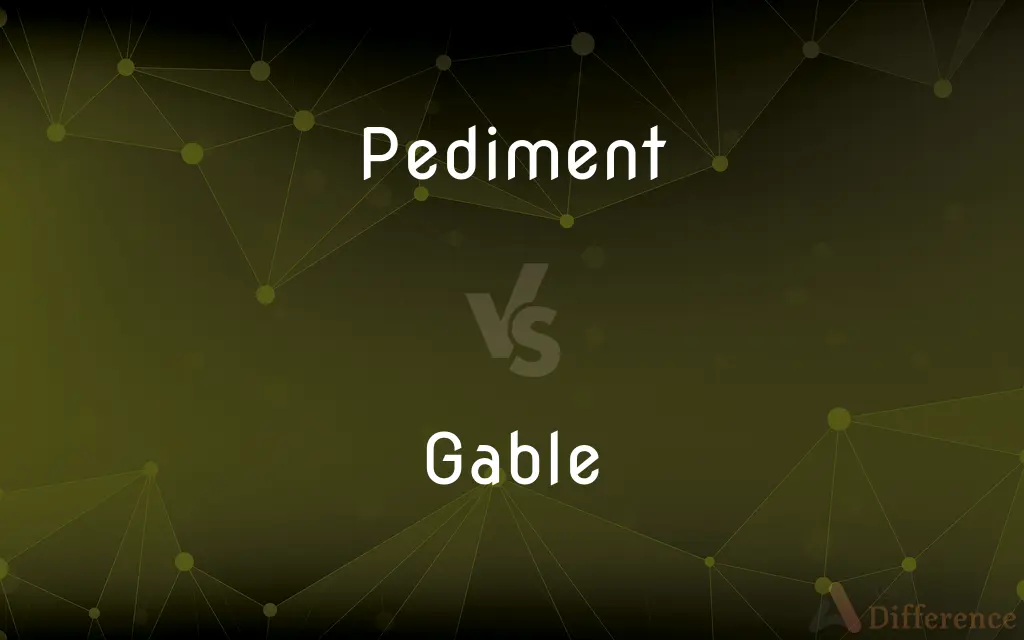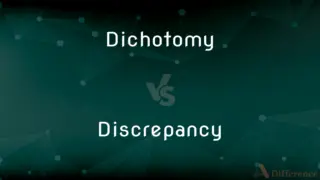Pediment vs. Gable — What's the Difference?
By Tayyaba Rehman — Updated on November 5, 2023
Pediment is a triangular upper part of a building facade or above a portico. Gable is the triangular wall end of a pitched roof.

Difference Between Pediment and Gable
Table of Contents
ADVERTISEMENT
Key Differences
Pediments and gables are both architectural elements found at the upper part of structures but serve different roles aesthetically and structurally. A pediment is typically seen in classical architecture, prominently featured atop columns or pilasters, forming a triangular shape that often contains sculpture or other ornamentation. A gable, on the other hand, is not limited to classical architecture and refers to the triangular portion of a wall between the edges of intersecting roof pitches.
The pediment is an element rooted in ancient Greek and Roman architecture, acting as a focal point above the entrance of temples, where it would often depict scenes of mythological importance. In contrast, a gable is a functional part of the roof, providing a way for rain and snow to slide off and can be seen in various styles of architecture, from Gothic churches to simple residential homes.
When looking at a pediment, one might notice its placement as part of the entablature, resting on a horizontal structure supported by columns, embodying the principles of symmetry and proportion. Gables, however, are defined by the construction of the roof, with the pitch of the roof determining the shape and size of the gable, which can vary greatly from steep in alpine architectures to nearly flat in modern designs.
The pediment, in its decorative function, often showcases the application of artistic design, such as in the famous Parthenon in Athens, where it once displayed intricate sculptures. A gable is less about ornamentation and more about necessity, yet it can be adorned or embellished, as seen in the crow-stepped gables of Dutch Renaissance buildings or the elaborate woodwork of Victorian-era homes.
Finally, while the pediment remains a symbol of classical ideals, often replicated in government buildings and cultural institutions to evoke grandeur and tradition, the gable serves a broader application, presenting itself in various forms from the simple to the ornate, highlighting the diversity of architectural expression in both historical and contemporary buildings.
ADVERTISEMENT
Comparison Chart
Definition
A decorative element above columns or a portico
The triangular end wall of a building
Architectural Styles
Classic Greek, Roman, and Neoclassical
Present in a wide range of styles worldwide
Function
Mainly decorative
Structural; supports the roof
Location
Above the horizontal structure of a facade
At the end of a roof ridge
Symbolism
Represents classical architecture and tradition
Often indicates the roof style and pitch
Compare with Definitions
Pediment
An ornamental feature resembling a classical pediment, used in various architectural contexts.
The fireplace was surmounted by a wooden pediment that added to the room’s elegance.
Gable
The generally triangular portion of a wall between the edges of a dual-pitched roof.
The gable's intricate woodwork made the simple cottage look quaint.
Pediment
The triangular upper section of a classical building's facade.
The pediment of the old courthouse featured a beautiful bas-relief.
Gable
A feature in a building’s architecture where a pitched roof extends outwards.
Each gable on the street was uniquely decorated for the festival.
Pediment
A crowning element of a building's entrance or facade, often triangular.
Each pediment in the university’s quadrangle depicted a different aspect of academic achievement.
Gable
The triangular upper part of a wall at the end of a ridged roof.
The house had a charming gable with a window that looked out over the valley.
Pediment
The triangular space at the end of a pitched roof in classical architecture.
The museum's pediment was adorned with sculptures from Greek mythology.
Gable
The triangular wall enclosed by the sloping edges of a roof.
He installed a window in the gable to brighten the attic space.
Pediment
A low-pitched triangular gable across a portico or facade.
The grand entrance was crowned with a pediment that bore the family crest.
Gable
The end wall of a building, from cornice or eaves to ridge.
The old barn’s gable was starting to show signs of wear and needed repair.
Pediment
A pediment is an architectural element found particularly in Classical, Neoclassical and Baroque architecture, and its derivatives, consisting of a gable, usually of a triangular shape, placed above the horizontal structure of the lintel, or entablature, if supported by columns. The tympanum, the triangular area within the pediment, is often decorated with relief sculpture.
Gable
A gable is the generally triangular portion of a wall between the edges of intersecting roof pitches. The shape of the gable and how it is detailed depends on the structural system used, which reflects climate, material availability, and aesthetic concerns.
Pediment
The triangular upper part of the front of a classical building, typically surmounting a portico.
Gable
The triangular upper part of a wall at the end of a ridged roof
A house with mock-Tudor gables
Pediment
A broad, gently sloping expanse of rock debris extending outwards from the foot of a mountain slope, especially in a desert.
Gable
The generally triangular section of wall at the end of a pitched roof, occupying the space between the two slopes of the roof.
Pediment
A wide, low-pitched gable surmounting the façade of a building in the Grecian style.
Gable
The whole end wall of a building or wing having a pitched roof.
Pediment
A triangular element, similar to or derivative of a Grecian pediment, used widely in architecture and decoration.
Gable
A triangular, usually ornamental architectural section, as one above an arched door or window.
Pediment
(Geology) A broad, gently sloping rock surface at the base of a steeper slope, often covered with alluvium, formed primarily by erosion.
Gable
(architectural element) The triangular area at the peak of an external wall adjacent to, and terminating, two sloped roof surfaces (pitches).
Pediment
(architectural element) A classical architectural element consisting of a triangular section or gable found above the horizontal superstructure (entablature) which lies immediately upon the columns; fronton.
Gable
(archaic) A cable.
Pediment
Originally, in classical architecture, the triangular space forming the gable of a simple roof; hence, a similar form used as a decoration over porticoes, doors, windows, etc.; also, a rounded or broken frontal having a similar position and use. See Temple.
Gable
A cable.
Pediment
A triangular gable between a horizontal entablature and a sloping roof
Gable
The vertical triangular portion of the end of a building, from the level of the cornice or eaves to the ridge of the roof. Also, a similar end when not triangular in shape, as of a gambrel roof and the like.
Gable
The vertical triangular wall between the sloping ends of gable roof
Gable
United States film actor (1901-1960)
Common Curiosities
What does a gable do?
A gable is the triangular wall between the sloping edges of a roof, which helps shed water and can add to the aesthetic of a building.
Can pediments be found on modern buildings?
Yes, pediments are used in modern buildings, usually to add a touch of classical grandeur.
Where are pediments most commonly found?
Pediments are common in classical architecture, such as Greek and Roman temples, and in neoclassical buildings.
Are gables decorative, structural, or both?
Gables can be both decorative and structural, depending on the design and style of the building.
Are pediments only triangular?
Traditionally, yes, but some modern interpretations can vary in shape.
Are pediments always at the front of buildings?
While typically at the front above the main entrance, pediments can also be found on the sides or rear of buildings.
What is a pediment?
A pediment is a triangular upper part of a building facade, typically above the entrance and often decorated.
Do pediments serve a structural purpose?
Pediments are primarily decorative but they can also help protect the underlying structure from the elements.
Is there any cultural significance to pediments?
Pediments often feature iconography or motifs important to the culture or function of the building.
Do all buildings with pitched roofs have gables?
Most, but not all; some buildings with pitched roofs may have a hip roof design without gables.
Can a building have both pediments and gables?
Yes, it's possible for a building to incorporate both features in its design.
What is the main material used for gables?
Gables can be made from the same materials as the rest of the building, commonly wood, brick, or stone.
How does weather affect gables and pediments?
Both must be properly maintained as they can be susceptible to weather damage, particularly in areas with heavy rain or snow.
What's inside the triangular space of a gable?
The space can be used as an attic, storage, or it may simply be the enclosed end of the roof space.
Can a gable be curved?
Yes, while gables are usually triangular, some architectural styles feature curved or scrolled gables.
Share Your Discovery

Previous Comparison
Erhu vs. Huqin
Next Comparison
Dichotomy vs. DiscrepancyAuthor Spotlight
Written by
Tayyaba RehmanTayyaba Rehman is a distinguished writer, currently serving as a primary contributor to askdifference.com. As a researcher in semantics and etymology, Tayyaba's passion for the complexity of languages and their distinctions has found a perfect home on the platform. Tayyaba delves into the intricacies of language, distinguishing between commonly confused words and phrases, thereby providing clarity for readers worldwide.















































